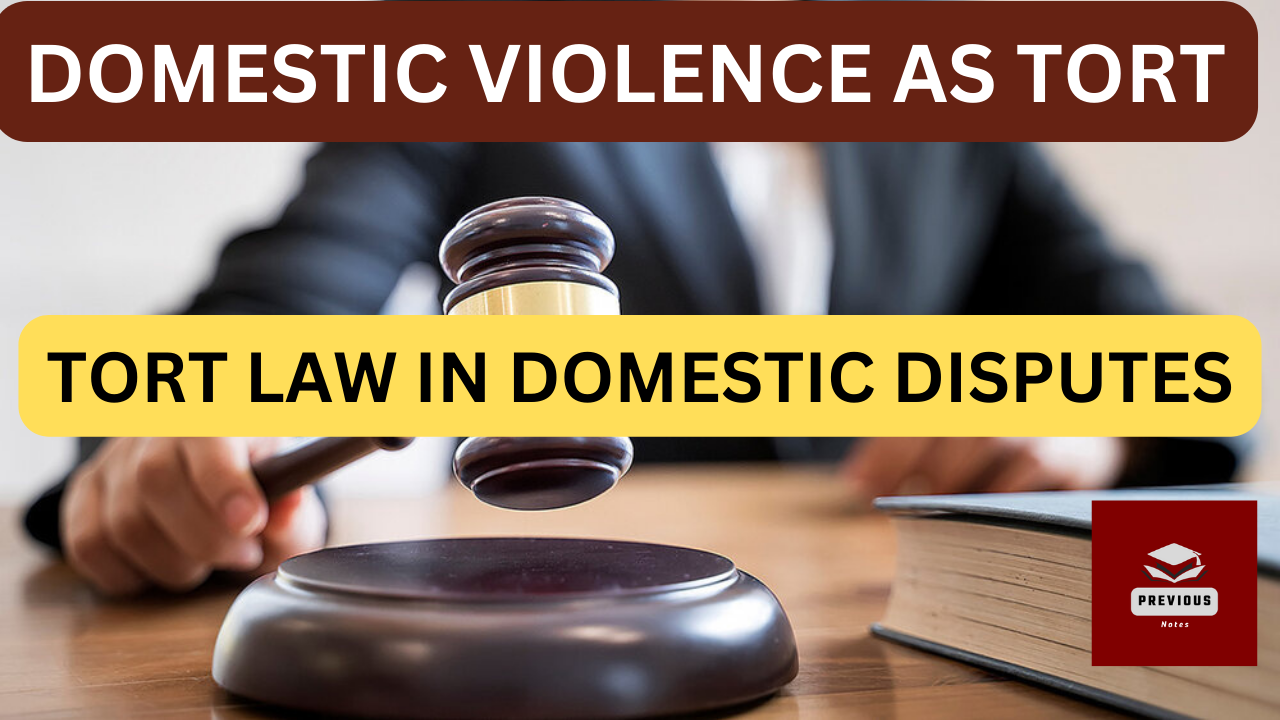DOMESTIC VIOLENCE AS TORT: APPLICATION OF TORT LAW IN DOMESTIC DISPUTES
Domestic violence as tort or Domestic Relations is an evolving area of Tort Law dealing with the internal functions of a family. This area focuses on the rights and obligations of family members and how tort principles can be applied to address wrongs and injuries within a familial context. No doubt it is the interference in the family unit itself and with this husbands, wives, kids, and legal guardians are seen as legal entity.
Evolving Areas of Tort Law in Domestic Relations:
- Interspousal Tort Claims: Historically, the doctrine of interspousal immunity prevented spouses from suing each other. However, many jurisdictions have abolished or limited this immunity, allowing spouses to bring tort claims against each other. Examples include:
- Assault and Battery: One spouse may sue the other for physical abuse.
- Emotional Distress: Claims for intentional or negligent infliction of emotional distress caused by abusive behavior.
- Parental Liability: Parents can be held liable for tortious acts that harm their children. This includes:
- Negligence: Failure to provide adequate supervision, leading to the child’s injury.
- Intentional Torts: Deliberate harm inflicted on a child by a parent, such as abuse.
- Third-Party Claims: Third parties can be held liable for interfering with family relations, including:
- Alienation of Affection: A claim against a third party who is alleged to have interfered with the marital relationship.
- Criminal Conversation: A tort action against a third party for engaging in sexual relations with a spouse.
Examples of Tort Applications in Domestic Relations:
- Domestic Violence: Victims of domestic violence can pursue tort claims in addition to seeking criminal charges against the abuser. This can include:
- Compensatory Damages: For medical expenses, pain and suffering, and emotional distress.
- Punitive Damages: To punish the perpetrator and deter future abuse.
- Invasion of Privacy: Privacy torts are particularly relevant in domestic settings where privacy is often breached. Examples include:
- Intrusion upon Seclusion: One family member spying on another, such as reading private emails or recording conversations without consent.
- Public Disclosure of Private Facts: Revealing private information about a family member to third parties.
- Defamation within the Family: Family members may bring defamation claims against each other if false statements are made that damage one’s reputation. For instance:
- False Accusations: One spouse falsely accusing the other of criminal behavior or infidelity.
Challenges and Considerations:
- Balancing Privacy and Accountability: Applying tort law within families requires a delicate balance between protecting family privacy and holding individuals accountable for harmful actions.
- Impact on Family Dynamics: Tort claims can exacerbate familial conflicts and have long-term impacts on relationships. Courts often consider the broader implications for family dynamics.
- Overlap with Family Law: Many domestic disputes involve overlapping issues in family law, such as divorce and child custody. Courts must navigate these intersections carefully to ensure just outcomes.
- Proof and Evidence: Proving tort claims within the family context can be challenging due to the private nature of many family interactions and the difficulty in obtaining evidence.
Role of Domestic violence Act 2005 In India:
Domestic Violence act is an remedial act which provide remedy to women who is in domestic relationship under the shared household. This Act is only for the women. Women can sue any person who is living with her under domestic relationship. It is a remedial act which provides remedy to the victim under Sec. 18-22 especially under which various orders can be passed.
Situation under Common Law:
While situation under Common Law was totally different from the one that we see now a days as we discussed above. In Common Law:
- Under Common law, a married woman could not sue any person for any tort in earlier phase of development of tort, unless and until her husband joined her as a arty to the plaintiff.
- Wife could not be sued without making her husband a defendant’s party.
- She could not sue her husband if he caused her personal injuries.
- Husband has no right for an action for any kind of harm caused by his wife to him.
Most of the anomalies were removed by the legislative acts. i.e. The Married Women’s Property Act, 1882 and the Law Reform (Married Women and Tortfeasors) Act, 1935
Case Laws:
Drinkwater v. Kimber (1952)
This case, explains the point. There a lady was injured because of the combined negligence from her husband and a third party. She recovered the full amount of compensation from the third party. The third-party could not recover any contribution from the husband as the husband could not be made liable towards his wife for personal injuries.
Regarding the contribution between the wrongdoers, the original rule in England was known as the rule in Merryweather v. Nixon. It stated that in the case of joint tortfeasors, the one tort- feasor who paid the full amount of damages for the wrongdoing could not claim contribution from the others.
The Law Reform (Married Women and Tortfeasors) Act, 1953) abolished this disability and enabled the joint tortfeasors to recover their contribution. The Law Reform (Husband and Wife) Act, 1962 has changed further and in this regard, the law has changed to the effect that when a spouse sues a third person, the latter can claim contribution from the other spouse who was a joint tort-feasor.
Broomy. Morgan (1953)
In this case, it was held that if a husband committed a tort against his wife in the course of his employment of his master, the master was liable for the same. DENNING LJ. observed: “If the servant is immune from an action at the suit of the injured party owing to some positive rule of law, nevertheless the master is not thereby absolved. The master’s liability is his own liability and remains on him, notwithstanding the immunity of the servant. The rule prohibiting action between spouses has been abolished by the Law Reform (Husband and Wife) Act, 1962. Now, the husband and wife can sue each other as if they are unmarried. The Act. however, places a restriction on the action during the marriage by one spouse against another and the court has been given a power to stay the action if it appears that no substantial benefit will accrue to either party from the proceedings, or the case can be more conveniently disposed of under Section 17 of the Married Women’s Property Act, 1882. Under Indian law, personal capacity to sue and be sued in tort between husband and wife is governed by their personal laws, be they Hindus, Sikhs Jains or Muslims. For Christians, the Married Women’s Property Act, 1874, removed various anomalies.
Cleary Booth, (1893)
Booth (Defendant), a school headmaster, admirlistered corporal punishment on two boys after learning that they had fought on the way to school. The defendant was charged with assault and battery and convicted for it.
The authority of a teacher to correct his students is not limited only to the wrongs which the student may commit upon the school premises but may also extend outside the school, for while “there is not much opportunity for a boy to the wrongs done by him to exhibit his moral conduct in school under the eye of the master, the opportunity is while he is at play or outside the school”
There is no question that, while at home, a child is under a parent’s authority. It is also clear that while at school, a child is under the head master’s authority. The question is under what authority the child is when he was on his way from home to school. Likely, the child may be said to be under the headmaster’s authority through the parent’s delegated duty. In that case, if necessary. the headmaster has the right to inflict punishment on the child in order to correctly raise the child. The authority of the headmaster extends not only to acts performed by children while they are at school but also on the way going to and fro from school to home. Here, the two boys were on their way to school when they are engaged in fighting. The defendant was well within his right to punish the boys.
You May Also Like:
Indian Penal Code MCQs Quiz: Section 1 to 5
Indian Panel Code MCQs Quiz on Section 511 and Attempt
IPC MCQs Quiz on Sec. 76 and Sec. 79 | Quiz on Mistake
Practice IPC MCQs online for free (Section 78)
Practice IPC MCQs Quiz for free | Section 81 MCQs | Necessity
Practice IPC MCQs online for free : Infancy (section 82-83)
Specific Principles of Criminal Law | LLM Previous Year Paper 2024 | CCSU
Specific Torts | LLM 4th Semester Previous Year Paper 2024 | CCSU
History and Basic Principles of Criminal Law | Previous Paper 2023
LLM Previous Year Paper 2023 | PRIVILEGED CLASS DEVIANCE
PENOLOGY PREVIOUS YEAR PAPER | LLM | CCSU
LLB Previous Year Paper 2023 | Constitutional Law II | CCSU
LLB Previous Year Paper 2023 | Legal and Constitutional History | CCSU
LLB Previous Year Paper 2023 | Jurisprudence II | CCSU
LLB Hindu Law Previous Year Paper 2023 | CCSU
Euthanasia in India, Right to die with Dignity
Right to Privacy Case Law Mr. X vs. Hospital Z
Federal Constitution Definition and key points
University of Madras vs. Shantabai,1954: Article 12 Case Law
Article 20 Fundamental Right with Case Laws
Article 19 Fundamental Right of Indian Constitution with 10 Case Laws
Article 358, 359 Fundamental rights during emergency
Parliamentary Privileges and Fundamental Rights with Case Laws
Article 14 Fundamental Right with Case Laws
Article 15 Fundamental Right with Case Laws
Article 12 Fundamental Right with Case Laws
DOMESTIC VIOLENCE AS TORT | APPLICATION OF TORT LAW
Crimes without Mens Rea? Statute without Mens Rea.
Definition of crime by various jurists, Criminology
Methods of Studying Criminology
All about Capital Punishment with Case Laws
IMPOSSIBLE ATTEMPT | ATTEMPT VS IMPOSSIBLE ATTEMPT
Difference between Preparation and Attempt
Tests to Determine Attempt and preparation | With Case Laws
Specific Principles of Criminal Law | LLM Previous Year Paper 2024 | CCSU
Specific Torts | LLM 4th Semester Previous Year Paper 2024 | CCSU
History and Basic Principles of Criminal Law | Previous Paper 2023
LLM Previous Year Paper 2023 | PRIVILEGED CLASS DEVIANCE
PENOLOGY PREVIOUS YEAR PAPER | LLM | CCSU
LLB Previous Year Paper 2023 | Constitutional Law II | CCSU
Forms of Judicial Process: Adversarial & Inquisitorial
DOMESTIC VIOLENCE AS TORT | APPLICATION OF TORT LAW
Economic Tort | Business Tort: Application of Tort Law
Crimes without Mens Rea? Statute without Mens Rea.
IMPOSSIBLE ATTEMPT | ATTEMPT VS IMPOSSIBLE ATTEMPT
Mistake of Fact Vs. Mistake of Law | Sec. 76 of IPC


















Leave a Reply